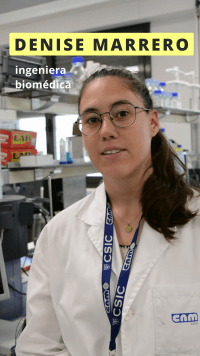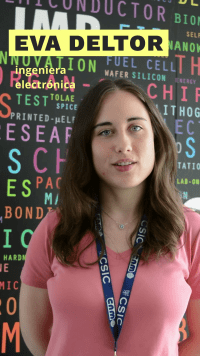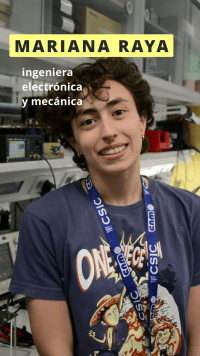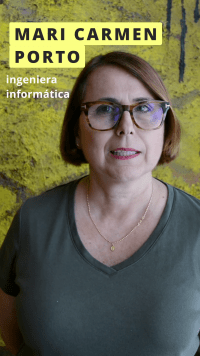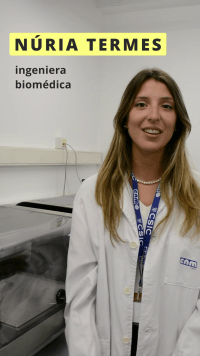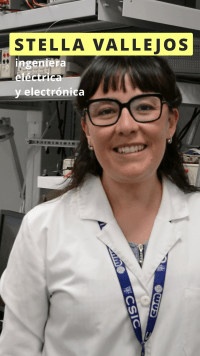They choose engineering: eight female engineers from the institute share their motivations
Electronical, biomedical, chemical... at the Institute of Microelectronics of Barcelona we have many female engineers with very diverse backgrounds, meet them for the International Day of Women in Engineering!
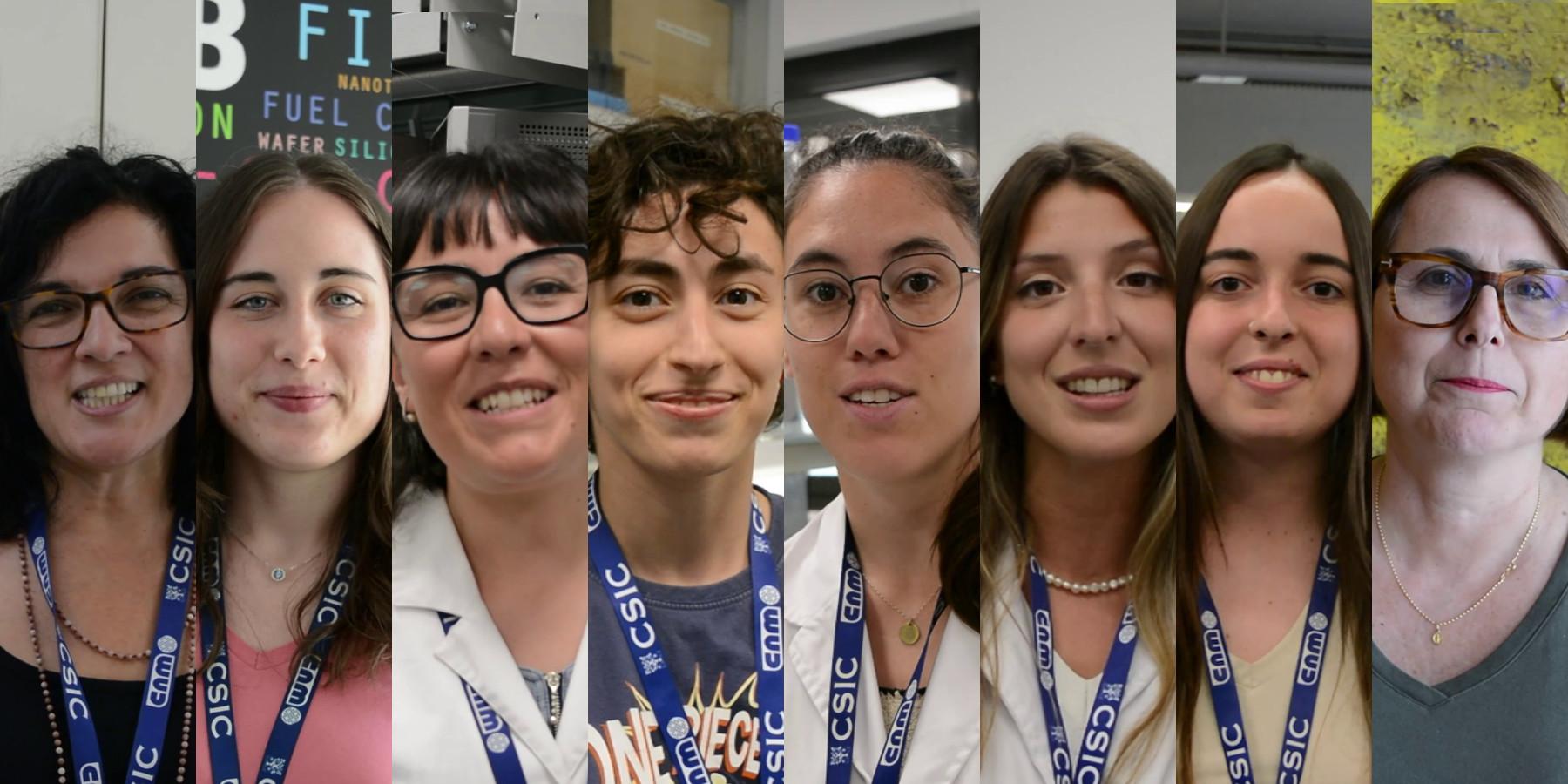
On the International Day of Women in Engineering (June 23), the Institute of Microelectronics of Barcelona highlights the work of eight women engineers, seven of them researching micro and nanotechnologies with applications in health, environment, semiconductor manufacturing or chip design; and one working in the field of Administration at the IMB-CNM.
Stella Vallejos, Marta Duch, Mari Carmen Porto, Eva Deltor, Denise Marrero, Mariana Raya, Eva Casals and Núria Termes have given brief interviews to learn more about their work and what motivated them to choose engineering at the time. All of them can be seen on video on the IMB-CNM Youtube channel.
Eva Casals Sánchez: electronic and biomedical engineer
Eva is studying a double degree in Biomedical Engineering and Electronic Engineering at the Universitat Politècnica de Catalunya (UPC). She is doing her final work (TFG) in the Biomedical Applications Group (GAB) in the field of wearable skin sensors, i.e. electronic devices that can be integrated into clothing or skin. She is in charge of the development of electronics capable of measuring physiological signals in tattoo electrodes within the Tatto4Sleep project. The initiative explores new technology for electronic devices on the skin to monitor sleep.
- Video location: Circuits and Integrated Systems Laboratory.
Eva Deltor Cortés: electronical engineer
Eva has a degree in Electrical, Electronic and Automatic Engineering from the UPC with a Master's degree in Electronic Engineering. She started in the field of electronic engineering motivated by her father, with whom she used to assemble robots when she was a child. Nowadays she is aware of the high impact that microelectronics has on the daily life of society and wants to create a positive impact with it. He did her final work (TFM) at IMB-CNM under the supervision of Francesc Serra-Graells, "A Low-Power High-Resolution Delta-Sigma ADC IP in 22-nm CMOS Technology for Smart Sensing Applications". She started her PhD just a year ago in the Integrated Circuits and Systems group (ICAS), where he is working on the design of a chip or integrated circuit for an infrared camera.
- Video location: IMB-CNM entrance.
Marta Duch Llobera: chemical engineer
Marta studied chemical engineering at the UPC because of her passion for chemistry. She joined IMB-CNM in 1994 to start up the Microsystems laboratory in the newly opened Micro and Nanofabrication Clean Room, dedicated to the manufacturing processes of microsystems, such as sensors or actuators. She is currently in charge of the area. Her work focuses on processes and post-processes focused on microsystems fabrication, such as silicon or glass micromachining and silicon-to-glass or silicon-to-silicon soldering techniques.
In addition, she is part of the Micro and Nano Tools group, dedicated to the fabrication of intracellular devices for the study of living cells. He actively collaborates with different research groups of the institute. One of the most outstanding projects in which she has collaborated is the introduction of chips inside living cells to act as "mechanical" drugs.
- Location of the video: perimeter corridor of the Clean Room.
Denise Marrero Feitosa-Afonsso: biomedical engineer
Denise is a biomedical engineer by the UPC because she was attracted by the multidisciplinary nature of the career. She extended her studies with a Master's degree in the Netherlands and is currently doing a PhD at the GAB of the IMB-CNM, also affiliated to the Centro de Investigación Biomédica en Red (CIBER-BBN). In her thesis, she is developing cell culture platforms, Organ-on-a-chip (OoC), in which to integrate sensors to simulate the human tissue environment. A couple of years ago, she explained her thesis topic in an IMB-CNM Talk: Gut-on-a-chip: mimicking and monitoring the human intestine.
- Video location: Biosensor Lab.
Mari Carmen Porto: computer engineer
Mari Carmen holds a degree in computer engineering from the Universidad Rafael Urdaneta in Venezuela. Over time she developed tasks in IT project management and worked for many years in the administration of the Port d'Informació Científica. She recently joined the IMB-CNM as administrative manager.
- Video location: corridors of IMB-CNM.
Mariana Raya di Francisco: electronical engineer
Mariana has a degree in Electronic and Mechanical Engineering from the Universitat Pompeu Fabra (UPF). She joined the IMB-CNM with a CSIC grant (JAE-INTRO) and here she did her Master's Thesis (TFM). She has recently started his PhD thesis in the Power Devices and Systems group (PDS). Her work focuses on chip embedding technology, where the chip is incorporated into the electronic board or PCB itself, for the development of power modules for sustainable mobility, such as electric vehicles.
- Video location: Electrical Characterization of Power Devices Laboratory.
Núria Termes Español: biomedical engineer
Núria studied biomedical engineering at the University of Vic (UVic) and specialized in Neuroengineering and Rehabilitation at the UPC. She is currently working at GAB on the development of self-adhesive skin electrodes, which would allow recording physiological signals in a more comfortable and efficient way.
- Video location: Printed Electronics Laboratory.
Stella Vallejos Vargas: electronical engineer
Stella is an electrical and electronical engineer from the Technical University of Oruro (UTO), Bolivia, and completed her PhD at the Universitat Rovira i Virgili (URV) in Tarragona. She is currently a researcher in the Microfabrication and Integration of Sensors and Energy Sources group (MESSI), where she works on the design and fabrication of silicon-based gas microsensors for the detection of gaseous species of relevance in the environment, security and agriculture. Her research projects include VISENS, funded by the Generalitat de Catalunya and in which his team manufactures microsensors to monitor wine fermentation and aging processes.
- Video location: Microsystems Characterization Laboratory.
Micro and nanoelectronics engineers
In the CSIC as a whole, the percentage of female researchers in the area of Matter represents 35.6% of the total according to the latest report of CSIC's Científicas en Cifras. In the case of the IMB-CNM, women account for 32% of the total research staff, 28% of technical staff and 33% of trainee staff, according to data from 2023.
In terms of education, the report Científica en Cifras of the Ministerio de Ciencia, Innovación y Universidades concludes that female university students in the science branch account for half of the total (50.8%). In the field of Engineering and Architecture, female students account for 26.5% of the total number of students in these fields.
Women in Engineering Day
The International Women in Engineering Day, officially on June 23, is an initiative born in the United Kingdom in 2014 by the Women’s Engineering Society (WES) as a platform for the visibility of women engineers, their careers and achievements. With the subsequent endorsement of UNESCO, the date has acquired the status of International Day.
The IMB-CNM Equality Committee takes advantage of the international initiative to give visibility to some of its female engineers and to promote interest in engineering among younger people.
